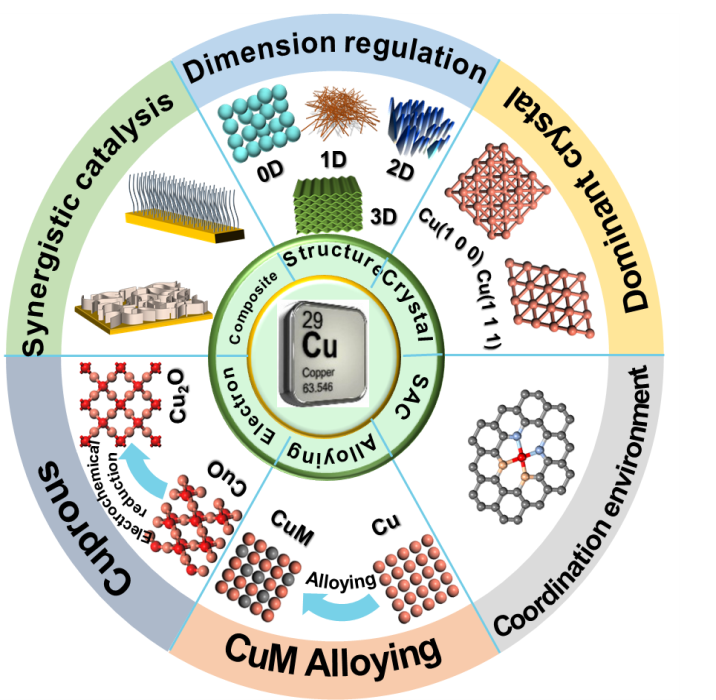 PDF(49221 KB)
PDF(49221 KB)


Cu-Based Catalysts for Electrocatalytic Nitrate Reduction
Changzheng Lin, Jinwei Zhu, Weijia Li, Hao Chen, Jiangtao Feng, Wei Yan
Prog Chem ›› 2024, Vol. 36 ›› Issue (9) : 1291-1303.
 PDF(49221 KB)
PDF(49221 KB)
 PDF(49221 KB)
PDF(49221 KB)
Cu-Based Catalysts for Electrocatalytic Nitrate Reduction
in recent years,electrocatalytic nitrate reduction(ENitRR)has attracted considerable attention in the synthesis of ammonia at ambient conditions.Compared to the traditional Haber-Bosch process for ammonia synthesis,ENitRR offers lower energy consumption and milder reaction conditions.the design and optimization of ENitRR electrocatalysts are crucial for nitrate deoxygenation and hydrogenation.copper-based catalytic materials have been widely studied due to their unique structure,low cost,and excellent performance,making them highly promising electrocatalysts through various morphology and electronic structure modulation strategies.This article summarizes various effective design strategies using copper-based electrocatalysts as a typical example to enhance the ammonia production rate and conversion efficiency in ENitRR.It also introduces the reaction mechanism and the relationship between structural changes in Cu-based electrocatalysts and their performance.These strategies include morphology modulation,alloy engineering,lattice phase tuning,single-atom structures,as well as copper compound construction and composites with other materials.Finally,challenges faced by copper-based electrocatalysts are discussed along with future research directions that should be focused on in order to provide reference for researchers engaged in nitrate treatment in aqueous systems。
1 Introduction
2 Mechanism of ENitRR
3 Research status of Cu-based electrocatalysts
3.1 Metal Copper(Cu0 )
3.2 Cuprous based catalyst
3.3 Copper matrix composite
4 Conclusion and outlook

copper-based electrocatalysts / electrocatalyst / nitrate reduction / design strategies
| [1] |
|
| [2] |
|
| [3] |
|
| [4] |
|
| [5] |
|
| [6] |
|
| [7] |
|
| [8] |
|
| [9] |
|
| [10] |
|
| [11] |
|
| [12] |
|
| [13] |
|
| [14] |
|
| [15] |
|
| [16] |
|
| [17] |
|
| [18] |
|
| [19] |
|
| [20] |
|
| [21] |
|
| [22] |
|
| [23] |
2023 Research Frontier, Institute of Science and Technology Strategy Consulting, Chinese Academy of Sciences, National Science Library, Chinese Academy of Sciences, Clarivate Analytics, 2023.
(2023研究前沿, 中国科学院科技战略咨询研究院, 中国科学院文献情报中心, 科睿唯安, 2023.)
|
| [24] |
|
| [25] |
|
| [26] |
|
| [27] |
|
| [28] |
|
| [29] |
|
| [30] |
|
| [31] |
|
| [32] |
|
| [33] |
|
| [34] |
|
| [35] |
|
| [36] |
|
| [37] |
|
| [38] |
|
| [39] |
|
| [40] |
|
| [41] |
|
| [42] |
|
| [43] |
|
| [44] |
|
| [45] |
|
| [46] |
|
| [47] |
|
| [48] |
|
| [49] |
|
| [50] |
|
| [51] |
|
| [52] |
|
| [53] |
|
| [54] |
|
| [55] |
|
| [56] |
|
| [57] |
|
| [58] |
|
| [59] |
|
| [60] |
|
| [61] |
|
| [62] |
|
| [63] |
|
| [64] |
|
| [65] |
|
| [66] |
|
| [67] |
|
| [68] |
|
| [69] |
|
| [70] |
|
| [71] |
|
| [72] |
|
| [73] |
|
| [74] |
|
| [75] |
|
| [76] |
|
| [77] |
|
| [78] |
|
| [79] |
|
| [80] |
|
| [81] |
|
| [82] |
|
| [83] |
|
| [84] |
|
| [85] |
|
| [86] |
|
| [87] |
|
| [88] |
|
| [89] |
|
| [90] |
|
| [91] |
|
| [92] |
|
| [93] |
|
| [94] |
|
| [95] |
|
| [96] |
|
| [97] |
|
| [98] |
|
| [99] |
|
| [100] |
|
| [101] |
|
| [102] |
|
| [103] |
|
| [104] |
|
| [105] |
|
| [106] |
|
| [107] |
|
| [108] |
|
| [109] |
|
| [110] |
|
| [111] |
|
| [112] |
|
| [113] |
|
| [114] |
|
/
| 〈 |
|
〉 |